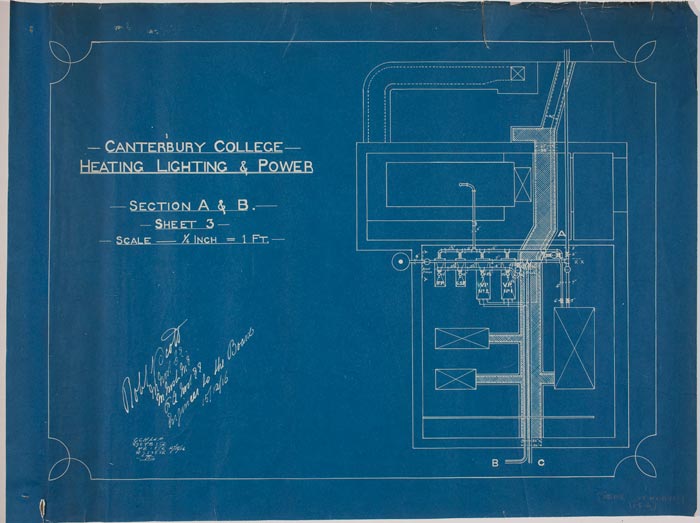One of Engineer Robert Scott's plans for heating, lighting and power at Canterbury College, 1916.

Light, Heat and Seats
Suffering from the cold was a common student complaint from day one of the College. Law student Brian Petrie summed the situation up in the 1940s. He recalled, “Heating and library were non-existent, lighting was poor, and seating uncomfortable.” Students shivering in their greatcoats was noted as part of the experience from the time of the College’s first lectures in the Public Library. Matters did not seem to improve greatly once the College had its own buildings, which initially relied on open fires for heat. Reportedly male students in the Stud Room were so cold in the winter of 1900, they burned the furniture in the room for warmth.

One of Engineer Robert Scott's plans for heating, lighting and power at Canterbury College, 1916.
Later buildings featured the inclusion of radiators but these did not appear to work any better. Chemistry students in 1920s were renown for choosing their experiments based on the heat they would create, because this meant they could keep warm. One such experiment involved the determination of halogens in carbon compounds by Carius’ method, which requires heating the compound with nitric acid in a sealed tube. One over enthusiastic student managed to shoot a tube out of the Chemistry Lab window straight into Hereford Street. Lack of funds for proper maintenance did not help matters. In 1947 the College boilers cracked and it took 8 years for them to be replaced. In the meantime the radiators were not workable, and many staff ran electric heaters off the light sockets.
Complaints about seating came a close second to those about the cold. Tiered wooden seats were not always the most comfortable. Correspondent ‘Wearie Willie’ wrote in 1906 “Sir – Allow me to raise my voice in painful protest against the seating accommodation provided in lecture rooms at Canterbury College. For real genuine discomfort (if not actual pain) it would be well nigh impossible to devise anything more ingenious.” He went on to catalogue that the seats were hard and flat, the rail behind them poked into ones spine, and the angle on the desks meant books would slide off. The surface of the desks deteriorated over time, often because of mistreatment by students. Law student Douglas Clemens recalled that desks in lecture rooms were deeply carved with names of former students, so deep in some cases that it made it difficult to write on the uneven surface.
Early lighting systems at the College were based on gas, but were eventually replaced by electricity. Where funding allowed, electric light in new buildings was organized to the highest standards. A 1916 letter from Samuel Hurst Seager, who became world expert in lighting for museums and galleries, outlines a plan for lighting for the new Library. Seager emphasizes need to eliminate glare, and provide separate lighting systems over shelving and over desks. “The question of lighting the new Library is of such vital importance that every care should be taken that it is carried out with the consensus of opinion of foremost Electro Engineers and Librarians.”

The first page of Samuel Hurst Seager's letter to the Board of Governors regarding Library Lighting, 1916.
For buildings already established on the town site, retrofitting electric lights had its drawbacks. Parts of the Engineering School had become such an electrical hazard by the late 1940s that students were advised to always wear sandshoes to provide effective insulation against electric shocks, and to keep their hands in their pockets so they wouldn’t be tempted to fiddle with switches. In general lighting levels were too low. A Council report on lighting levels in College in 1943 found that many lecture rooms had illumination of only the value of 2 to 3 foot candles, which they described as the same as that deemed suitable for churches as a ‘dim religious light.’